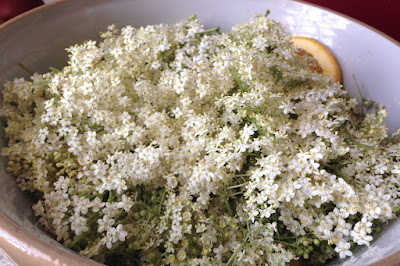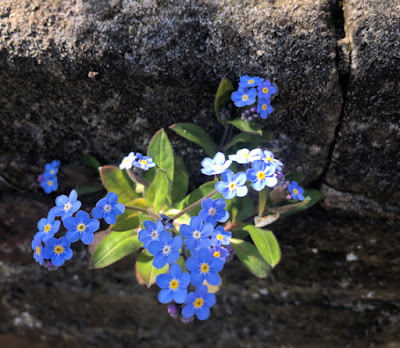 |
| The appearance of the first asparagus in April. |
I feel slightly ungrateful saying this but wasn't April a bit too hot? April is known as a gentle month of moderate temperatures - frosts even - and certainly not known for the baking heat that chilli peppers enjoy. I, on the other hand, am not a chilli pepper so do not enjoy extreme heat and have had to limit my gardening to stay out of the midday sun. Gratifyingly, April obliged by a return to form in the last week of the month with three whole days of solid rain, gently soaking into the parched and cracked earth. Such a treat for gardener and garden alike, I could almost hear the plants sighing with relief.
I had a wander round in a rare dry interlude; I love how perky seventy two hours of intermittent rain has made the garden. Like Jack’s beans, plants seem to have magically doubled in size overnight. Care to join me for a little garden tour?
The Balcony
April started with minnow daffodils flowering in pots and ended with overwintered cape gooseberries (physalis) starting to flower.Like every other gardener, trays of tomatoes, brassicas, courgettes and squash seedlings have been coaxed into surviving and thriving despite heat and wind. Unusually, by mid-month I was leaving all seedlings - including tomatoes, but not chillis - outside overnight in warm still air. They’re not quite big enough to be planted out yet but it will be good to reclaim my balcony when the weather settles down.
The chilli pepper seedlings have been very slow this year. Should I have sown in the chillier winter months? Probably. But, as the saying goes, I'll just keep calm and carry on.
The best thing though - and I highly recommend this - is having a tray of baby salad leaves nearby. Only three weeks after sowing (and with regular watering) I had baby leaves to eat. Earlier from this same tray, I snipped micro greens for salad toppings and to thin out the tray; then came the baby leaves; now I have cut and come again plants that I could plant out to grow on to full size. This supply of fresh salad leaves has been much appreciated while I wait for the salad garden to grow.
The Salad Garden
This secluded sheltered corner adjacent to the railway line is rapidly becoming my happy place; it would only be made more perfect by seeing one of the old steam trains puffing past while I’m there. (I once saw the Hogwarts Express on this line; I was waiting with my then 7 year old son for our regular train when the Harry Potter train puffed towards us. I almost spontaneously combusted with excitement.)Anyway, one month in and No.1 Veg Trug is filling up nicely. I’m aiming for a mini salad bar where I can pick all the necessaries for a lunchtime salad - a choice of lettuce leaves plus chives, spring onions, radishes, mini carrots, rocket and lamb's lettuce. (Tomatoes will eventually go in a third Veg Trug, hopefully before the end of May.)
And, in case you're wondering, I'm not going to eat the marigolds but they make very good companion plants (supposedly deterring pests such as whitefly) plus they brighten things up. And they were cheap from the supermarket - as if I needed a reason to buy plants!
No 2 Veg Trug was sown three weeks after the first, roughly the third week of the month. Seed choices differ slightly from No 1 trug; this time I’ve sown endive, beetroot (for leaves. roots and colour), pink chard, purple carrots, and herbs - basil, flat leaf parsley and, I hope, chervil. Is chervil slow to germinate? It’s yet to put in an appearance, unlike the parsley seedlings which are known to be very slow off the mark but are shyly poking up above soil level.
Hotbin composter - yes, I have recently acquired one of those, having despaired of the wooden composter in the veg patch that was looking a little too rustic after ten years service. The Hotbin is supposed to make compost in just one or two months; I’ll do a full post once the first batch is done.
The Veg Patch garden
The month started with wild garlic, tulips, honeywort and blossom. Strong winds blew the pear blossom to the ground, cherry blossom clung on and apple blossom came after - in the heat.By mid month the nasturtiums, comfrey and sweet woodruff were flowering, peony stems popped up, and every branch of the Core Blimey apple was smothered in blossom. The garden soundtrack was of bees happily pollinating and birds singing. I'm quietly optimistic of a good year for this tree.
The month closed with alliums, elderflowers, broad bean tops and sweet cicely flowers turning to delicious seeds.
Plants for this year's veg garden are still in pots on my balcony until conditions are right for planting them out, but a walk around the veg patch gives thinking space for planning how to fit it all in - and what needs to come out. The wooden raised beds have done sterling work for ten years but are now falling apart. That’s the main reason they’re coming out but also because they provide a nice hiding place for snails; once they’ve gone, I can be more flexible with the space.
This year I've succumbed to growing Brussels sprouts having discovered how utterly delicious they are cooked with bacon. And what would I do in winter without broccoli, leeks and kales of various hues and textures? Late autumn will see butternuts, pumpkins, and squashes ripening. At a gardening event in February I was given seeds for two new squashes that will supposedly taste of potato when cooked - one mashed, the other baked. I remain sceptical but I have to try, don't I?
Broad beans are still flowering and black aphid free (for now) so I’ve been taking the tops for steaming with butter - a useful side vegetable and delicious. The Russian kale has started to flower, bumble bees are having a feast and I’ve decided to leave one plant to grow on for seeds. This kale is not only beautiful but very good to eat, with sweet young leaves.
But what to do about the asparagus bed? The (few) purple spears are so delicious when freshly picked but, in such a tiny plot, is giving over the space justified? I plan to companion plant basil and tomatoes into the gaps (staying clear of the fragile asparagus crowns) but the debate rages on. Have any readers tried moving asparagus crowns? Please, let me know if you have and whether it was successful.
The Washing Line Border
This is my low maintenance drought area, bordering the circular drying lines. It’s low maintenance because it gets no attention beyond having horsetail and herb robert pulled out and 'drought garden' as the hosepipe won’t reach. And it gets full sun in the summer months.
So it changes, year on year, depending which plants can survive such harsh conditions. This year’s star plants for April are the lavender and erigeron. I swear they weren’t looking so lush a couple of days ago - all that rain must have given them the boost they need. I’m now thinking I should throw a bucket of water over this patch from time to time.
The Lime Tree Garden
(aka the Car Park Garden)
So many lovely things happening here - what a month! This time last year I was still laying out the structure of the garden. Most plants were still in pots as I played with where to home them so this year I’m watching carefully to see what works and what might need moving.
So many lovely things happening here - what a month! This time last year I was still laying out the structure of the garden. Most plants were still in pots as I played with where to home them so this year I’m watching carefully to see what works and what might need moving.
This will take some thought as the garden is usually shaded, but there's more light this summer as a result of the three mature lime trees being pollarded into leafless pillars at the end of last year.
A few plants kept the borders green over winter but in April the border came alive with crocosmia leaves waving, and white campanula flowering very prettily next to an unknown brassica that I was given. The lychnis coronaria (rose campion) has trebled in size. I so loved this plant growing wild at the allotment plots that I bought one for the garden; I don't remember it being this big at the plots. This border is another area that needs adjusting; there's a new peony in there as well lavender, scabious and who knows what else that may have thrived or died over winter!
The next border along was earmarked for soft fruit, with maybe a few veg tucked in. I'm not rigid in my rules and sprinkled some old flowers seeds around last autumn. This was done with very little expectation but those seeds have produced a sea of white and blue nigella. Very pretty growing around the gooseberries.
Ah, the aquilegia! This predates my custody of the garden has reliably bloomed mid-month. So pretty; I wish it would seed around a bit like they're supposed to.
Blueberries - I have three plants but never get a heavy crop from these as they are, of necessity, kept in large pots. But that's the joy of gardening, you never know what to expect. Maybe this year I'll harvest more than a bowlful.
 |
I won't mention the chilean guava or jostaberry this month as they're showing no signs of fruiting. Hmm. Hopefully more to report next month on those.
Likewise the ranunculus. Yes, they did bloom again from last year's corms but were over very quickly this year. I blame the heat. Again.
Let me finish with a quick look at the spring border. Gorgeous in February and March but now it has quite lost it's charm and become overrun with hellebores and honesty seedlings. I pulled out a lot of those seedlings but stopped before it all became too drastic. The saving grace in April was the too brief appearance of the lily-of-the-valley that I brought back from my mother's garden and the bleeding heart plants. I need to give this a lot of thought; strong coffee might help.























